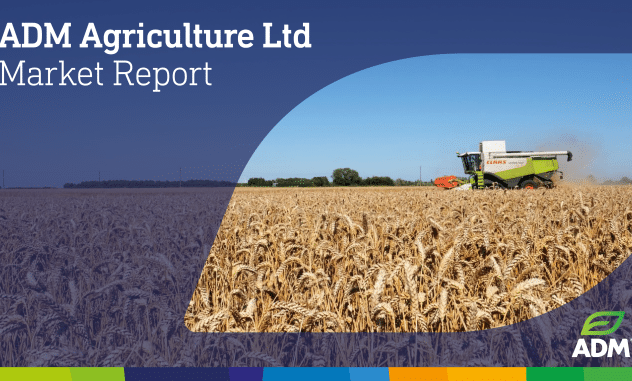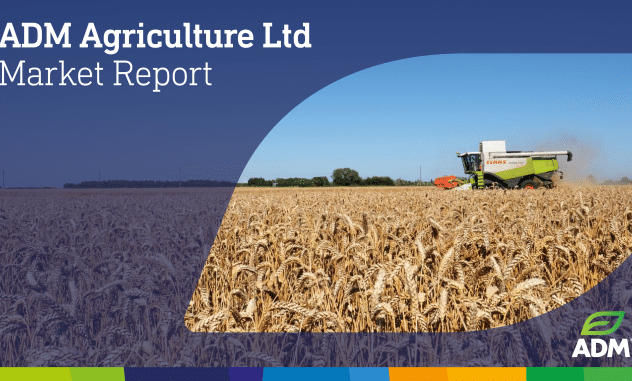WELCOME TO THE ADM AGRICULTURE WEEKLY MARKET REPORT
Wheat
- At the end of last week we saw a real acceleration of prices to the upside driven by short covering ahead of a long US weekend, a weakening dollar and ongoing weather concerns. These were further fuelled by US crop ratings reports this week which confirmed downgrades to corn and spring wheat crops primarily in the USA.
- While winter wheat is improving at 38% good/excellent, the wheat ratings report was more centred around spring wheat which dropped 9% to 51% good/excellent. Spring crops nationally are 10% headed but well ahead in South Dakota at 50% vs 33% average, which puts crops in a vulnerable condition given the lack of precipitation in the forecast.
- For corn, ratings fell 6% to just 55% good/excellent with the expectation that the USDA’s yield of 191.5 bushels per acre will be dropped in the next report. For context, SP Global put its predicted yield at just 177bpa.
- US weather remains dry for the 7-10 day forecast and continues to be one of the main price drivers as concerns over corn and spring wheat crops heighten. Intense heat seems restricted to Texas, where harvest is underway, and parts of the western corn belt. Rains are expected this week for much of the South East and western North East through the Northern plains, but most of the central corn belt remains dry until at least 26th June.
- Brazil’s safrinha (second corn harvest) is currently 5% complete vs 11% a year ago with logistics becoming a big problem as huge crops scour the market for homes and export bids. Crop estimates are rising with most now tipping over the 130mln t total (USDA 132 mln t). This offers a significant juxtaposition to the dwindling US crop, but is being largely ignored by the bulls in this market. London wheat futures continue to track firmer markets elsewhere, trading £25/t up from early June’s lows. Fundamentally, the UK has a storm brewing with an exportable surplus of around 2.5 mln t whilst remaining uncompetitive against cheaper origins. Domestic demand has picked up slightly given recent price movements, as has farmer selling, but you still wouldn’t describe this as a liquid market as you’d expect with a circa 16mlt t crop on the way.
Malting Barley
- Malting barley markets remain supported following the recent weather market caused by dry conditions in Scandinavia. It does however feel as though the rally is running out of steam following some rains in the region and the onset of harvest in France.
- Local commentators in France are optimistic about crop prospects. Yield forecasts for both winter and spring crops are 10-15% over average in many regions.
- Meanwhile in the UK, recent rains have benefited spring crops in particular, and many growers remain optimistic about the coming harvest.
- The malting barley market has been the biggest riser of all over recent weeks. As a result, premiums over feed look like excellent value to growers, well in excess of £60/t – we would recommend locking in some premiums at these levels.
Feed Barley
- On the eve of the barley harvest, the market is focussing solely on execution for the coming weeks. Sellers continue to hunt for export demand; however only some small pockets of demand can be found in Ireland. Meanwhile, we are completely uncompetitive into Spain against aggressively priced Black Sea origin.
- Domestic markets in the deferred positions remain supported relative to wheat as farmers continue to withhold grain from the market. With a tightening barley balance sheet and heavy domestic wheat supplies, we expect that this spread will remain supported going later into the season, meanwhile, we expect harvest in particular to feel further pressure
Rapeseed
- Russian forces continue to target Kyiv along with other western regions of Ukraine; in return, Ukrainian forces sent drones toward Moscow. The US and China still have underlying tension following US officials visiting China last week.
- CBOT Soybeans continue to rally this week with the trade seeing little change in the US weather situation. Though some areas saw rain across the Midwest over the weekend, it wasn’t deemed enough to improve conditions. Further showers are in the forecast for the South/South-East next week, but equally, the trade is still apprehensive that rain will materialise.
- As expected, US soybean crop conditions fell, but were reported below trade expectations at 54% good/excellent yesterday down from 59% last week,. The average trade estimate came in at 57%. Dr Cordonnier lowered his US yield estimate by 0.5 bushels per acre to 51 bpa.
- Whilst soybeans rallied back to highs, soy oil traded sharply lower following the US Environmental Protection Agency’s decision on biofuel mandates for 2023 onwards, which fell below trade expectations. As a result futures traded limit down all of yesterday’s session and are again lower today.
- In South America, with harvest nearly over in Argentina, Dr. Cordonnier lowered his crop production estimate to 21mln t from 22mln t last month, compared with USDA’s figure of 25mln t.
- Crude oil prices seem to have found a trading range in the short term. Oil is still flowing from Russia to China, which may lead Russia to increase production. That may mean Russia selling to Iran, Iraq, and others.
- Canadian canola and Matif rapeseed markets both hit nearby highs on the recent weather market and lack of farmer engagement at lower levels. However, weaker oil markets in the last few sessions have pressured prices as we get closer to EU harvest.
- Here in the UK sterling traded down to 1.16000 in expectation of higher interest rates being announced today, which supports domestic prices.
Oats
- Oat markets have proved hard to establish this week, given the lack of sellers from the usual EU exporters.
- Demand for spot oats continues with buyers in both Iberia and North Africa looking for old crop supplies to cover Jul/Aug positions with offers few and far between.
- Feed oats are valued for July at a significant premium to feed barley and this is leading to a wider differential for new crop positions, with oats typically indicated at a €30-50 premium to feed barley. Typically oats would be a €10-25 discount to attract feed demand.
- Reports from Scandinavia and the Baltics are suggesting a significant reduction in oat production prospects due to the hot dry conditions. However, until harvest starts we will not know the scale of the damage.
- The reluctance of consumers in Europe to pay up for new crop oats is coinciding with a lack of selling pressure from farmers to create an illiquid market.
- Here in the UK, the huge flow of exports has taken its toll on the available old crop surplus, and with over 160,000t exported year to date we could see 170,000t shipped by the end of Jun’23.
- Development of spring oats continues to be a concern given the lack of rainfall. However, recent showers and forecasts for further rain next week should bring sufficient moisture to prevent crops from losing further yield potential.
- Bottom line, the EU oat market is currently facing a tighter old crop balance sheet than was first thought and new crop is likely to be hard to trade until we know the quality.
Pulses
- Peas:
- The old crop pea market is completely done, with no farmer selling and feed peas in very short supply/demand.
- New crop-wise, the rain this week in England will have done no end of good for the UK pea crop after the prolonged dryness we saw through the first half of June and the majority of May. Independent agronomist Keith Costello has told us he expects the rain to have a positive impact on yields and provide the crop with much-needed moisture ahead of the next crucial stage.
- With the crop well established now, it is key for growers to manage insects which can prove harmful to quality. This is why I recommend any pea grower to visit the PGRO’s YouTube channel to watch the organisation’s video on how to effectively manage pea moth during this period, particularly while the UK continues to get warmer through the remainder of the summer when pea moth is more prevalent.
- Beans:
- Old crop appears finished as farmer selling is very quiet.
- New crop wise we have seen a slight increase on farmer selling week on week. This could be due to the winter bean crop looking impressive at this stage.
- Quality varies significantly across the country and field to field. Spring crops predominantly do not look great, however, this could depend on when they were drilled. Later drilled crops appear to have suffered more than those that went in earlier.
Seed
- As autumn cropping decisions are now being made, availability of a few key varieties is now starting to be tight.
- We expect Champion winter wheat seed to be in high demand, due to the excellent disease resistance the variety has shown in trials this year. Grouse from RAGT’s portfolio is also proving to be a popular choice on farm this year, mainly due to the variety carrying the BYDV resistance gene, offering growers security on farm and the opportunity to reduce insecticide sprays across holdings. For winter barley, Tardis is looking to be an excellent choice, particularly on heavier sites, with its excellent standing power. Tardis from KWS is the only variety on the list to have a rating of 8 for resistance to lodging both with and without PGR.
- If you are considering drilling OSR this autumn, why not spread the risk with one of our varieties supported by an establishment scheme, with up to £100/pack rebate available for crops that fail to establish?
Fertiliser
- The focus this week in the European nitrogen market is the assessment of the immediate impact of the reimposition of the 6.5% tariff on urea being imported into the EU from other origin destinations and a 5.5% tariff on ammonia imports.
- Options become limited for traders into the region, although some North African producers have the most attractive terms due to their Free Trade Agreements with both the UK and EU.
- North African FOB offers have reportedly seen increases of $10-20/t following the news and increased sales.
- Ammonium nitrate remains relatively flat at present with a premium still being seen on the products on a £/kg N basis.
- Both urea and ammonium nitrate at present offer attractive Break Even Ratios against the current wheat price which has seen some more interest in nitrogenous products this week.
- ADM has high-quality compound from SKW Piesteritz – Piamon 33N 30SO3 still available, highly suited to OSR applications. Speak to your ADM Farm Trader today to secure your requirements.
- Alternative PK options from ADM provide secondary and trace elements at a discount to traditional bagged products, whilst also reducing machinery and labour workload at harvest, Speak to your ADM Farm Trader today for more information and grades available.
| £/€ | £/$ | €/$ |
|---|---|---|
| 1.1615 | 1.2740 | 1.0970 |
| Price Range | Feed Barley £ | Wheat £ | Beans £ | Oilseed Rape £ |
|---|---|---|---|---|
| July 2023 | 155-165 as available | 180-195 | 250-255 | 355-365 as available |
NB: Prices quoted are indicative only at the time of going to press and subject to location and quality.
“Although ADM Agriculture take steps to ensure the validity of all information contained within the ADM Agriculture Market Report, it makes no warranty as to the accuracy or completeness of such information. ADM Agriculture will have no liability or responsibility for the information or any action or failure to act based upon such information.”
ADM Agriculture cannot accept liability arising from errors or omissions in this publication.
ADM Agriculture trade under AIC contracts which incorporate the arbitration clause.
Terms and Conditions of Purchase.
On every occasion, without exception, grain and pulses will be bought by incorporating by reference the terms & conditions of the AIC No.1 Grain and Peas or Beans contract applicable on the date of the transaction. Also, we will always, and without exception, buy oilseed rape and linseed by incorporating by reference the terms & conditions of the respective terms of the FOSFA 26A and the FOSFA 9A contracts applicable on the date of the transaction. It is a condition of all such transactions that the seller is deemed to know, accept and understand the terms and conditions of each of the above contracts.



